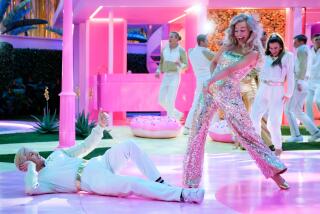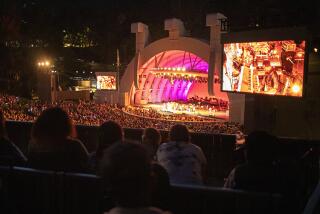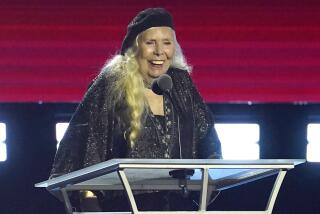Review: Two CD sets unearth thrilling rare gems from Hollywood Bowl Symphony
“If by the number of appearances in films and postcards we judge the most iconic of Hollywood landmarks, the palm has to go to the Hollywood Bowl,” Leo Braudy writes in “The Hollywood Sign.” But the most famed outdoor concert venue in America has never been the subject of so superb a cultural history of Los Angeles as Braudy’s on the Hollywood sign.
The Bowl’s history remains hard to measure and remote. Only a handful of the hundreds of thousands who attend each summer even notice, let alone drop into, the bewitching Hollywood Bowl Museum while walking up Peppertree Lane to the amphitheater’s main entrance. So when a few rare recordings from the late 1940s and early 1950s of the onetime Hollywood Bowl Symphony Orchestra turn up, they automatically have the aura of revelatory artifacts.
That is the case of the exceptionally hard-to-find performances by the Bowl Symphony on two recent CD sets on the Music & Arts label, one devoted to violinist Camilla Wicks and the other to conductor Leopold Stokowski. They are thrilling.
In 1944, while living in L.A. with his glamorous new wife, Gloria Vanderbilt, Stokowski founded the Bowl Symphony, drawing from L.A. Phil members, Hollywood studio players and young musicians to indulge in a wide mix of music. It was a short-lived venture, in part because the Hollywood moniker made the orchestra hard to be taken seriously in serious circles, and it was refashioned as a more pops-oriented ensemble in the 1950s and later reborn in 1991 as the current Hollywood Bowl Orchestra.
__________
For the Record, July 8, 11:15 a.m. An earlier version of this review incorrectly stated that the current Hollywood Bowl Orchestra was reborn in 1990.
___________
In hindsight, we can see the feisty original band was ahead of its time, especially in its breaking down musical barriers. For instance, Stokowski inaugurated the orchestra by inviting 56 local composers from film, popular music and the classical world (Schoenberg was included) to write fanfares.
The main point, though, was that the orchestra had flare. On the Wicks set, there are an electrifying 1946 live performance of Wieniawski’s Second Violin Concerto conducted by Stokowski and an arrestingly eloquent reading of Tchaikovsky’s Violin Concerto recorded at a 1953 concert conducted by William Steinberg.
Treasurable as they are, these little-known recordings are but a small part of the five-CD Wicks set that does noble service resuscitating an unjustly neglected great violinist who was born in Long Beach and who turns 97 next month.
Maybe better remembered these days as a legendary educator, she was, in fact, one of the great violinists of her time. If so richly expressive and dynamic a player with peerless intonation and flawless technique never had the career of many of her golden-age contemporaries, it was partly because she was a woman and partly because she became a devoted mother of five during her prime.
But the extent to which she has been neglected is appalling. She was one of Sibelius’ favorite soloists, yet the 2006 CD reissue of her brilliant 1952 recording of his concerto has become so hard to find that used copies begin at $289.49 on Amazon. It is not on this current set, but there is a treasure chest here of solo material that includes a gripping performance of Ernest Bloch’s First Violin Sonata (another composer who thought the world of Wicks) from a recital at Cal State Fullerton in 1980.
The three-CD Stokowski set is mainly devoted to restoring old 78 rpm recordings the conductor made with his All American Youth Orchestra. This was a pioneering experiment in 1940 and 1941 of creating the exciting training orchestras we now find all over the world. Performances of Tchaikovsky’s “Pathétique,” Stravinsky’s “Firebird” and Stokowski’s alarmingly vivid orchestration of “Pictures at an Exhibition” and amazing symphonic syntheses of “Boris Godunov” and “Tristan und Isolde” are on fire.
The handful of Bowl Symphony Orchestra recordings, made in 1946, are minor miniatures, each the side of a 78. But the personality of the Hollywood players is irresistible, and Stokowski’s startlingly succulent arrangements of a Brahms Hungarian dance and Strauss waltzes must be heard to be believed. The sound is often rough, but Music & Arts has done an outstanding remastering job, restoring a lost era.
More to Read
The biggest entertainment stories
Get our big stories about Hollywood, film, television, music, arts, culture and more right in your inbox as soon as they publish.
You may occasionally receive promotional content from the Los Angeles Times.







